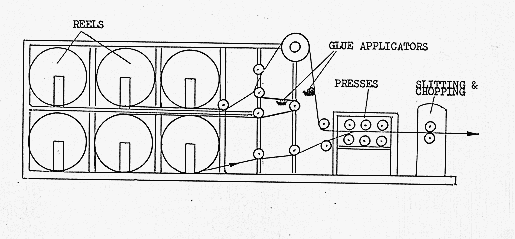Pkg Solutions
Quality Glossary
THE MANUFACTURE OF SOLID BOARD
While loosing market share for much of the last three
decades, solid board packaging still has a niche market in items such
as fish boxes, etc. and is described below for the benefit of packaging
students.
DEFINITION
Solid fiberboard for case making is composed of 2 to
5 plies of board laminated together on a machine called a "paster".
The multiple plies distinguish solid fiberboard from carton board which
is just one ply produced on a board machine.
TYPES OF BOARD
In any combination, solid board consists of one or more
layers of container middles, normally with an outer liner of light weight
laminating Kraft. In some instances a Kraft liner is also used on the
underside of the board.
The total caliper of the board is determined by the
number of plies and the caliper of each, and the outward appearance by
the color of the Kraft liner. Standard container middles in use are 0.024"
and 0.030" in caliper (610 and 762 microns) and the standard Kraft
liner 0.00411 (70 microns). The variation in numbers and caliper of the
various plies permits a range of solid boards of 0.038" to 0.10211
total caliper.
|
 |
Further variation can be
obtained by using 0.01511 (260 microns) wet strength Kraft and 0.02811
(700 microns) aquapruf middles, to product such as Aquapruf solid board.
Water resistant adhesives are used in the lamination of this product. |
THE PRODUCTION OF SOLID BOARD
The various plies are laminated on a paster which consists
of a series of reel stands, glue applicators, a drying section and a slitting
and cutting section. Schematics of the production process are shown below:
Reels: Reels held in position pre laminating.
Adhesive Application: Glue is applied to middles.
Pressing and Drying: The various plies are brought together.
Finishing: The laminated board is cut to required blank
size.

Starch adhesive is used for laminating container middles
to Kraft liners and silicate between plies of container middles. P V A
is used when producing Aquapruf board. The application of too much adhesive
will require a lower running rate. It is important at this stage that
the board is held at the correct tension and the edges are aligned.
Pressing and Drying
After the liners and middles meet at the nip roll, they
pass through a series of driven rolls, after which they are carried along
under pressure through the curing section before leaving the combiner.
The pressure section is between 20 to 50 feet in length and each set of
rolls placed consecutively applies a higher degree of pressure, to ensure
that the adhesive is not squeezed out along the edges of the board. To
keep the board an even caliper between each set of rollers, the pressure
rolls vary in diameter by approximately five thousandths of an inch, with
the larger roll first, making each set of rolls pull just a little faster
than those proceeding.
Finishing
After leaving the pressure section, the board passes
under tension to the rotary trimming and slitting knives which cut the
board to the required case blank width. Trim from edges of the web is
removed as a continuous strip, and is collected in scrap boxes for removal.
The manufactured strips are then chopped to the required case blank length.
Some pasters are equipped with duplex cut offs. Sheets are finally discharged
from the paster where they are manually stacked at the take off. Manual
methods are employed as the board sometimes warps precluding the use of
automatic machinery. The take off operator also checks the quality of
the blanks leaving the paster.
Schematic of Laminating Process

Reels
Most pasters can laminate 5 plies of board and will
have 10 reel stands, thereby having a reserve reel for each ply for changeover
during running.
One reel is fed from the top, the next from the bottom,
thus causing the edges of the web to push against each other to prevent
curling.
Kraft rolls would be placed at the two ends of the reel
stand with the container middles in the center, in the same relative order
in which they are combined into solid board.
Adhesive Application
The plies are pulled through the gluing and drying sections.
Glue is applied by rolls before the plies are brought together at the
nip. In making solid board, no adhesive is applied to the top or bottom
liner. Generally, the adhesive is applied to the top and bottom of the
first ply of container middles and to the bottom of each of the second
and third plies when making five ply board.
